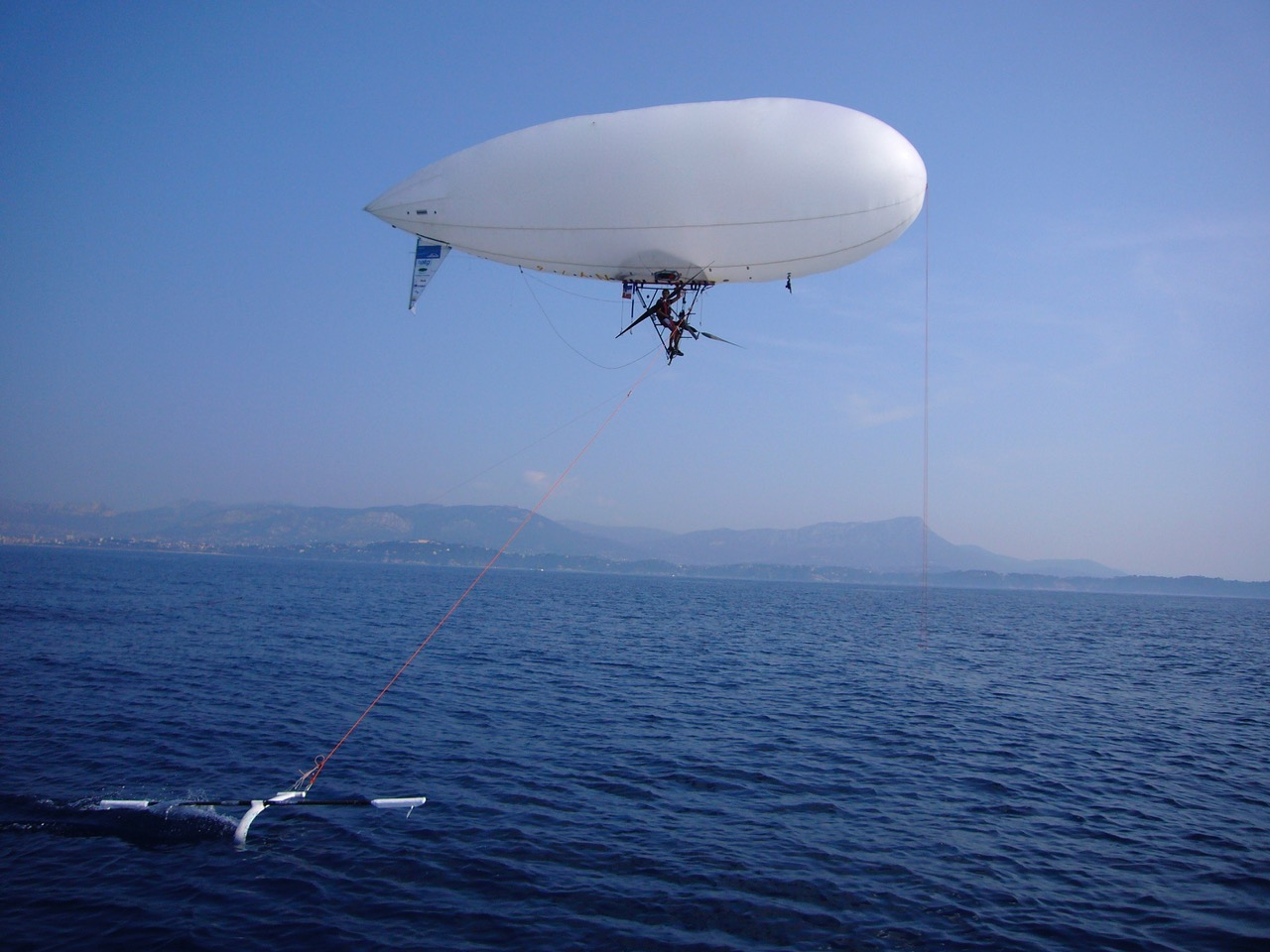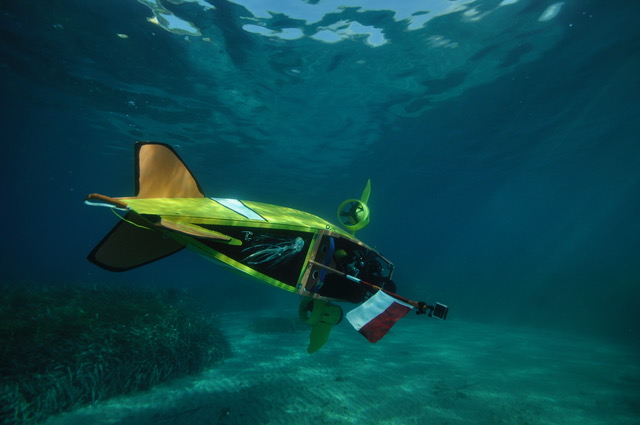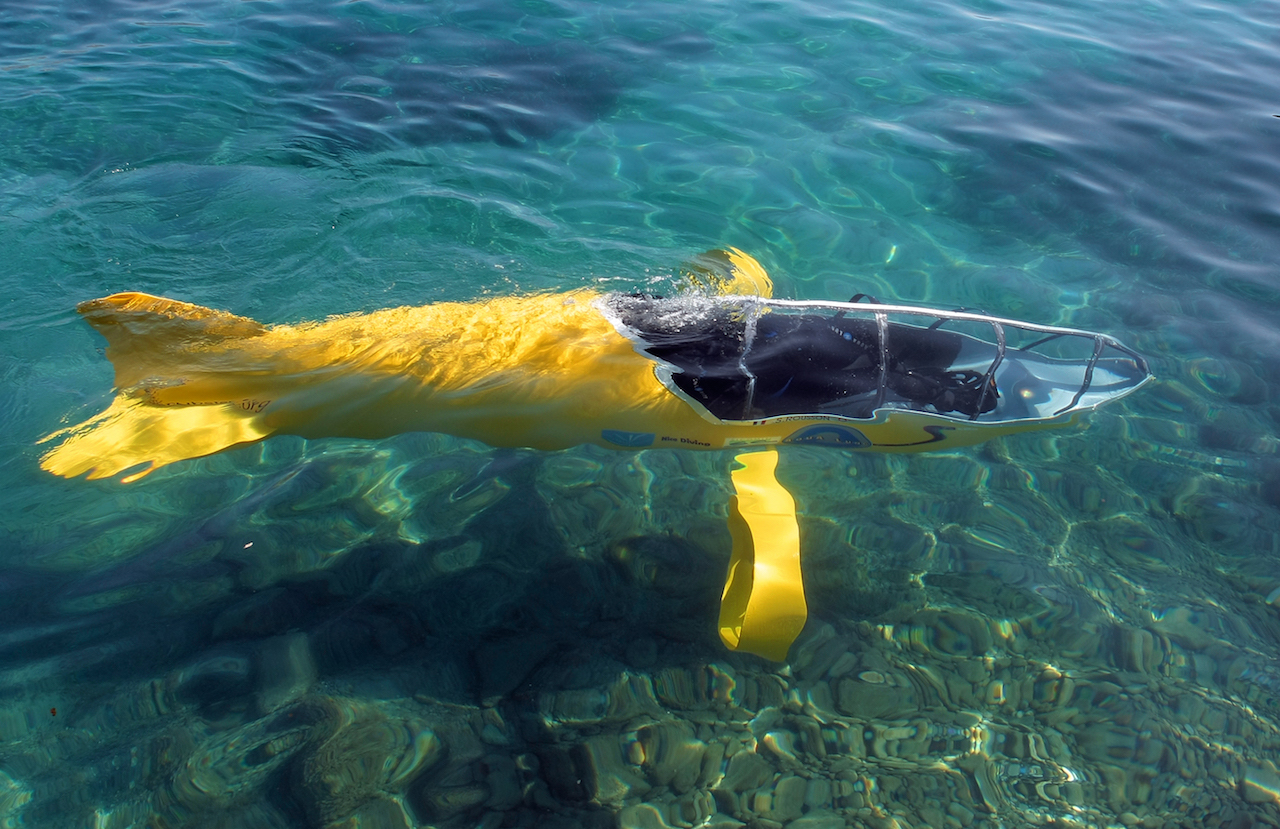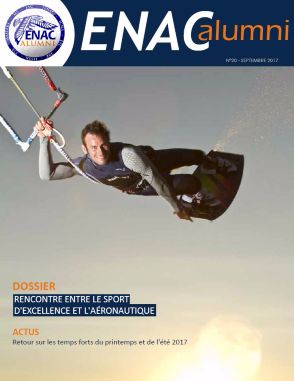News

Stephane Rousson, this "magnificent man in his Flying Machines" between sky and sea
"Take a short break with ENAC Alumni summer issue and discover articles from our previous mag"
Aeroceanaut – a word specially crafted by the astronaut Jean-François Clervoy, to describe him Stéphane Rousson is neither an athlete per say nor is he a common pilot. If the ATPL ( Airline Transport Pilot License) training often leads to FL350 ( Flight Level 350), Stéphane took advantage of his aeronautics know-how to create revolutionary environment-friendly vehicles flying between sea and sky – where utopia starts.

Can you explain the basics of operating and piloting the muscle propulsion airship?
It is a subtle mix of heavy flight and light flight… The muscular part is basic mechanics allowing a streamlining of the weakness of our legs: 150 watts… doping aside! Using bigger propellers make it possible to achieve a better output and thrust. An exciting research topic with possible links to e-propulsion (or sailing propulsion) particularly exciting to study and develop.
The airship part is more complex because mastering the arts of piloting is particularly critical to manage airships! Refer to my book co-authored with Simon Theuveny on airships of less than 900 m3. It would then make sense to re-read the airship flying manual along with university academics in order to give a better meaning to all those current airship projects of which there is no reference manual whether about piloting or building guidelines.
What is essential to have in mind is that an airship is above all made for heavy flights. And in our case I can only perform heavy flight around 500 grams… which is a very narrow room indeed for maneuver when you need to offset the lift variations of the airship.
See the flight and lift calculator that we have developed with the mathematician Marcel Deleuze.
2 degrees in heat variations are enough to become either too heavy or too light, making things more complex.
It is a kind of flight where constant anticipation of what you see is paramount and solid knowledge in visual meteorology is required to detect any potential hazard.
From 2003 to 2008, you were totally dedicated to these flying machines and you worked on a project about flying across The Channel with the airship Zeppy. Can you share this adventure with our readers ?
An adventure I wrote about in my book Travel to The Edge of Utopia co-authored with Laurence Latour.
This adventure came to life from my willingness to achieve an unparalleled technical breakthrough. The main interest in the crossing is meteorological because this lagoon-like sea with changing winds, sea breezes from each shore is one of the most difficult challenges a low altitude, low speed and low power flight must tackle.
The most daunting hardships I faced were a lack of funding that would have allowed me to quietly sit there waiting for the best weather and above all train and delegate a large part of the workload. Tiredness mainly was unfortunately behind my first failure and also partly to blame for my second failure.
I tried again twice in 2008 and again in 2016 for a TV channel with a different pilot. And why not try again this kind of adventure or tackle a similarly daunting challenge like a flight bridging Nice to Corsica, to make a bit of change.
To sum it up, what matters most is trying for understanding. I have wonderful memories from that challenge and I also met interesting people as well as annoying ones and faced a long string of hardships.

This issue of our magazine is a showcase for ENAC (National School of Civil aviation) graduates who opted to dedicate themselves to a sport-related activity. With Zeppy you chose instead to make the opposite move, bringing back the physical challenge to piloting. So the muscle-propelled airship is above all a physical adventure or is it an aeronautical challenge ?
Before all else it is an aeronautical adventure, mainly because the low power enables you to lift 180 kg … with 150 watts! It is more a tough style exercise than a muscular challenge. If 5 billion people are fit enough to pedal, very rare are those people able to fly pedaling: rarer still than astronauts !
And this is understandable, it is a very complex challenge (either for aircrafts, airships with pedals or helicopters) but a very exciting adventure both for the mind and the overall understanding of aeronautics – from flight mechanics to flying rules!
Both the Aerosail and the Seaglider are air vehicles whose piloting depends upon an element of sea navigation. How does it work? Why are these two systems interesting ?
Aerosail is an innovative development that allows piloting an airship just like a sailboat. It is about taking advantage of the wind only as a means of propulsion while flying a few dozen meters above the waves. This way of flying is unparalleled in the world as of today.
I am very eager to witness the implementation of such a project and why not in partnership with ENAC by passing on the technology. Aerosail is an airship linked to a stabilizer on three axes (Seaglider) allowing the airship to navigate just like an air sailboat would do.
The Seaglider is the equivalent of a “stabilizer” for a sailboat. The cable connecting the Seaglider to the airship works as a mast and the balloon serves as a sail. It is basically a sailboat with a super-efficient and super-light hull allowing navigation at speeds twice to three times those of the wind.
Offshoots of this technology are already spreading in the field of Kite Surfing and sailing.
And yet another innovative development with the Scubster. It is more or less a hybrid plane and submarine ?
It is even a balloon that converts into a submarine… It uses Archimedes thrust! And it is also very close to piloting a VTOL (Vertical Takeoff and Landing) aircraft. Our technological edge is this: the ability to maneuver with only two engines with no need for stabilizers or controls. The aim was to use our knowledge on Archimedes thrust and low power propulsion to adapt the balloon to the underwater environment. This technique is very similar to aircraft piloting and balancing approach. We were awarded the very coveted prize for innovation at the Naval Warfare Center of Bethesda, Maryland (United States).
What is the underlying thread linking all these projects ?
First and foremost it is about pleasure. Then the willingness to achieve a technical breakthrough that we deem possible with all the knowledge acquired in our small brains. And when some know-how is still necessary, then it’s about going to the right place and gather the great team that will deliver… I can’t achieve much alone. It is a team work, a big team work.
What are your main sources of innovation and inspiration ?
Comic books, inventors, scientists, technology, curiosity, the desire to do things differently and bring new approaches and solutions.
Do you have more ideas in mind ?
Yes too many… and why not put some students in this field? It would really be exciting to launch a new Scubster team to try to win new innovation prizes during submarine racing events in the USA or in Europe. This kind of adventure is very well suited to the field of space training like swimming exercises and as the only French participant in 20 years of competition, I am looking forward to passing on my ideas and motivation to launch a great academic adventure in this field. (several winners turned astronauts…!).

In 2007, you answered the call of AirExpo by showcasing Zeppy in one of the hangars of the Francazal Air base. What are your memories of that event and what do you think of the initiative of our students ?
I have a nice memory of the event even though the weather did not allow us to make an outdoor stunt. I also remember some aircrafts flying that day. Organizing such an event is always a daunting task and it is paramount to believe in one’s motivation to deliver. It is critical as well to be coherent and convincing in order to bring crowds, companies, etc.
Last Word :
The world of aeronautics is fascinating. Just one caveat: not clean (environment-friendly) enough…
So what’s the purpose of muscle propulsion: understanding low powers and maximizing output.
I wish the advent of fully electric planes so that the aviation industry could do without jet fuels.
Time to fun
Further informations :
Find the whole file "Meeting between the sport of excellence and aeronautics" in the Mag#20 of ENAC Alumni

















No comment
Log in to post comment. Log in.